White lilies: varieties and cultivation

White lilies are often used for garden decoration. They look aesthetically pleasing, differ in decorative and medicinal properties, and can be components of many compositions. These flowers require laborious maintenance, but their beauty is worth it.


Hybrid groups and varieties
Lilies are bulbous perennials. In nature, they are especially common in the northern part of Asia.
An abundance of varieties and species can be found in Western China, Northern Burma and Tibet. In landscaping, gardeners most often use the Apollo hybrid.
First of all, consider the description of garden varieties.

Lily white
It can grow up to 100-150 cm. A round onion up to 15 cm in diameter consists of light scales, sometimes with a slight yellow tint. The stem is smooth, light green. There may be small streaks of magenta. Smooth leaves are also light, expanding downward. The lower leaves grow in the form of a rosette, and the upper ones are arranged alternately.
The funnel of the flower is wide, the petals are snow-white. The pollen has a characteristic yellow color. The capsule acts as a fruit. Candidum (white lily) blooms in June-July. The flower is propagated by seeds or scales from the bulb.


Lily regal
It can grow up to 120-180 cm. A round bulb with a diameter of 10-15 cm consists of yellow scales, sometimes with a brown tint. In sunlight, it takes on a purple hue. The stem is light with purple streaks, ribbed. Leaves are linear and alternate.
The racemose inflorescence can contain up to 30 tubular flowers, the length of each can reach 15 cm. The petals are white on the inside and pinkish on the outside. In the throat, shine and light yellowness. Pollen with a characteristic yellow tone. Lily blooms in July, closer to the middle of the month. For reproduction, seeds, stem bulbs and scales are used.

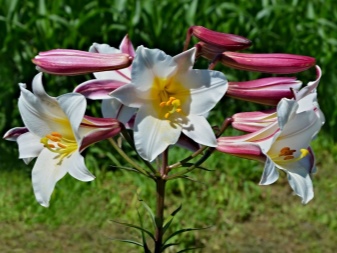
Lily hybrids are just as popular as pure varieties. All of them are bred on the basis of a snow-white lily and look very beautiful. Perianths are usually tube or wide funnel-shaped.
Flowers with a diameter of 10-20 cm are located on stems, which can reach 120-180 cm. Hybrids of this type require close attention, they often suffer from fungal diseases and do not like the cold.

Several plants stand out among the most popular hybrids.
- Apollo. Flowering occurs in June-July. Snow-white petals are dotted with small dots of a dark shade closer to the middle of the flower.

- Madonna. The flowers are perfectly white, about 12 cm in diameter. They have the shape of tubules and bent petals. Flowering occurs at the same time as the previous hybrid. The aroma is delicate, light.

- White Haven. The flowers are long, about 15 cm in diameter. They are white with a slight green tint towards the middle. The petals are slightly curled. The stem is small, it grows up to 110 cm. The plant blooms all summer.

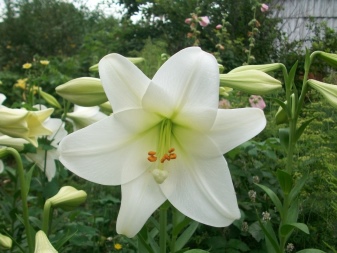
- White Fox. The flowers are white with a slight yellow tint. The stem can grow up to 130 cm in height. The flower is in the form of a tube, about 12 cm in diameter.

- Pretty Woman. The stem is high, can reach 180 cm. The plant blooms throughout the summer. Large flowers have a light creamy shade, turn slightly pink towards the center.

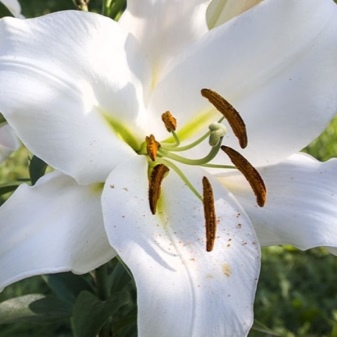
- "Aaron". A hybrid native to Asia. Small petals are covered with a kind of terry at the edges and have a pure white tint. The stem height is small (up to 80 cm). Flowering begins in June and lasts until July.
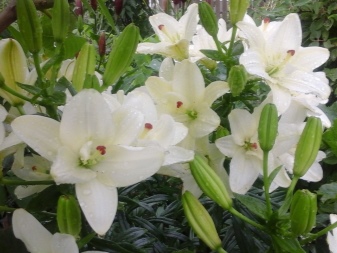
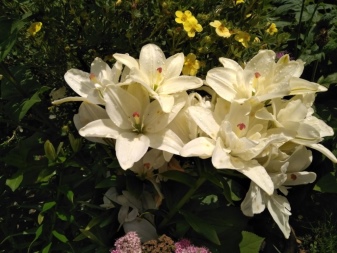
Planting and leaving
Lilies will only look attractive if properly cared for.
Hybrids grow better in alkaline soil, and tubular varieties grow better in acidic soil. For the rest of the lilies, you need to choose a neutral soil. For the winter, plants need to be covered - cold is contraindicated for them.

There are general rules for keeping all varieties and hybrids.
- It is important that the bulbs are not flooded in the spring. If there is such a possibility, then you need to take care of the drainage layer. During rainy periods, this technique will protect the bulbs from rotting.
- Fertilizers should be mineral, not organic.
- For the winter, it is recommended to transplant the bulbs into a basket. Otherwise, there is a great risk that the lilies will be eaten by rodents.
- Plants are more susceptible to disease in rainy seasons. It is necessary to carry out additional treatment with drugs.


For outdoor planting, it is important to choose a healthy bulb. In this case, you can plant the plant in both spring and autumn. Procedure order:
- remove dry scales from planting material;
- pour a small layer of sand on the bottom of the hole, no more than 3 cm;
- put the onion in the hole, sprinkle with sand to the top;
- water generously for better rooting.



It is important that in the fall the plant gives roots before the onset of the first cold weather. At this time of the year, it is necessary to additionally mulch the soil.
Sawdust, peat, leaf humus with peat additives are used as insulation. The mulch layer should be at least 5 cm.
Snow-white lilies require special conditions of detention. It is important to consider a number of nuances.
- The sun should hit the leaves only before lunchtime. Plants do not tolerate heat and frost.
- It is impossible to plant completely in the shade. Light is needed for proper development.
- You need to feed the plant with fertilizers three times. Before the flower begins to grow, before flowering, when the buds are forming, and after the flowers fall until August or September.
- Watering is carried out with the regularity in which the ground is always slightly moist. Water must be directed to the root.


Reproduction methods
The plant can be propagated in different ways depending on its species. The easiest way is to use the method of dividing the bush. Every 3-4 years in late summer or early autumn, you need to dig up the plant and separate the bulbs.
You won't be able to plant many flowers in this way. It should be noted that some types of lilies do not form additional bulbs in the bushes. It is important to act carefully, as if unraveling the inflorescences. In this case, the roots will not be damaged and will take in well. For the next season, the lilies will bloom as violently or even stronger.
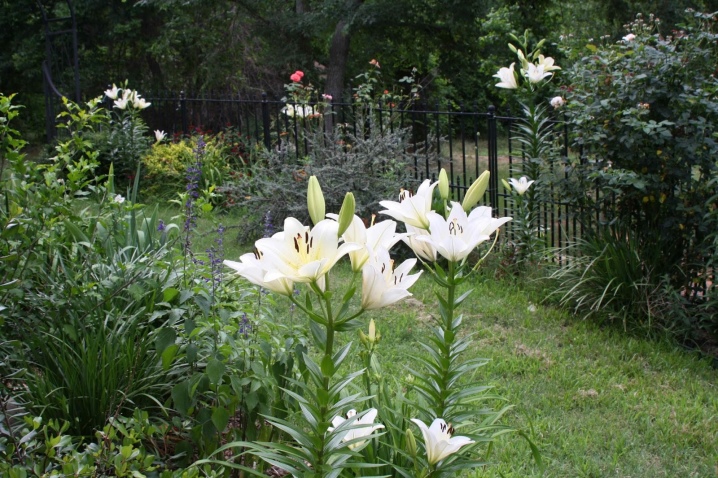
Gardeners use more complex types of division, which allow you to plant many specimens at once. Here are some popular ways.
Children
In the fall, they dig up a bush and look for small bulbs. They are located in the underground part. Some species form up to 10 of these daughter bulbs. They must be separated and planted separately to a depth of about 3 cm. For the winter, the soil must be carefully covered with straw or foliage.
During the year, the plant should develop, therefore, when buds appear, they must be removed. The mother bulb, if necessary, is planted in its original place.
A year later, next fall, you can plant small lilies in flower beds and flower beds.

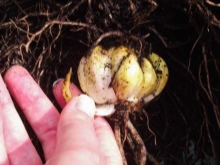
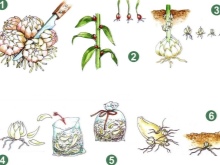
Stem cuttings
Young shoots up to 15 cm in size are removed in spring and processed with Kornevin. A pot of nutrient-rich soil is prepared. Can be planted directly into open ground, sprinkling with sand, but only if weather conditions permit. The shoots are watered abundantly and covered with a plastic bottle without a lid.
With proper moisture, the roots appear within 10-14 days. The bottle must be removed, and the shoot spud. A flower garden transplant is carried out in August, and flowering begins in 1-2 years.

Flower shoots
This method is used after the plant has faded.The peduncle is cut at the right time or used after the bouquet has wilted. A furrow about 2 cm deep is dug in the shade, and the length should be equal to the size of the shoot. Exceptionally light and loose earth with additives is used.
Before planting, the plant must be watered with any growth stimulant solution. The planting site is covered with foil. After 60 days, bulbs appear that should not be replanted until next spring. In winter, the land is covered with peat or sawdust.
This method can even be used for breeding on a windowsill. Shoots are transplanted into open ground in spring.

Leaves
The snow-white lily reproduces well by this method. A fragment of the plant is cut off when the buds are formed. The leaves are planted in the ground in half with a slight slope. It is recommended to plant lilies in a container with drainage holes.
The vessel must be filled with loose soil with a layer of up to 6 cm and river sand - up to 4 cm. From above it is covered with polyethylene. The shelter must be removed and turned over daily to remove any condensation that has formed. You can remove the bag after 30 days, when small bulbs are formed. Lilies are transplanted into open ground in the spring or fall of the next year.


Scales
This method is used at any time of the year, even in winter. The mother bulb remains intact, and a lot of planting material can be obtained. The outer scales are carefully removed, but no more than 1/3 of the total.
From the outer layer, 5-7 bulbs can form at a time under good conditions. Lilies grow in a year, but bloom for the first time only after 3 years. The method is applicable to all varieties and hybrids.
It is necessary to take a plastic bag or container, make holes for drainage. Any loose soil and substrate is used for filling. You can use a mixture of peat seedlings.
Flakes are placed in a container and covered with moist soil. The bag must be tied and left for 30 days in a room where the air temperature is kept within + 22 ... 24 ° С. You can plant scales in pots in 1.5-2 months, not earlier. You can plant it in the ground in the coming season. Flowering will appear in 1-2 years.


Seeds
Used for specific flowers. Hybrid lilies do not propagate that way. The process is quite laborious and long. Beginners do not use it at all, only breeders and usually for breeding new, unique species. The boxes should be taken brown, not yet open.
Cotyledons can grow both above and below the ground. A large number of seeds are planted directly into open soil on prepared beds. If there is little planting material, then containers are used first. This is how lilies grow like any other seedling. The care is standard, as with a normal landing.


Diseases and pests
Among the dangerous beetles, it is worth noting the lily beetles. These are the most common pests and must be removed manually. The larvae of these beetles are especially dangerous for the plant. They eat the leaves. Additionally, it is worth processing flowers from Colorado beetles.
Diseases rarely affect white lilies, but may appear botrytosis or fusarium. Fungal infections of the first type affect the leaves, and the second, the bulbs. It is difficult to treat such diseases and usually it does not work.

As a preventive measure, it is recommended to soak the bulb in a manganese solution before planting. And also you can use the medicinal preparation "Maxim" for watering under the root.
White lilies are susceptible to certain viruses. Usually there are cucumber mosaic, tulip variegation virus, rosette. Carriers are aphids and other pests. Leaves and stems begin to turn yellow, change shape and become stained. The affected parts must be torn off and burned, the plant must be treated with drugs and the inventory must be sterilized.
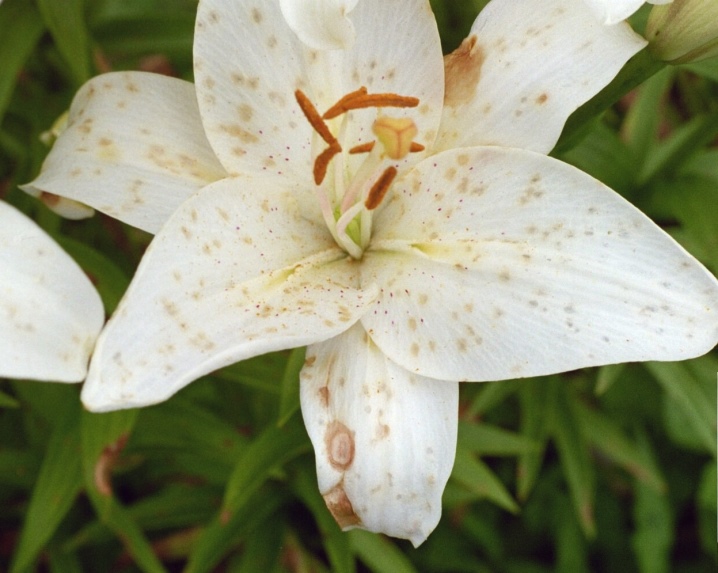
Examples in garden design
Lilies are usually planted with other plants.During the flowering period, the aroma is so strong that it can cause headaches and allergic reactions. In landscaped gardens and in the front area, lilies cannot be planted in a large separate planting. Many flowers will have to be cut after wilting, which will affect the overall aesthetics.
White plants look beautiful in rose gardens and in flower beds of tapestry and bouquet types. Here are some good examples of options for combining lilies.
- Different varieties. A flower garden from different groups or species of one group looks attractive and interesting. The lower tier should bloom first, and the upper tier last.
- With peonies. Flowers in front should be lower than in back. Lilies with a low stem in front of the peonies look harmoniously.
- With roses. The color should be the same or contrasting. Roses are placed in front of the lilies. Flowers are planted in small groups, no more than 5 copies.
- With phlox. It is worth giving preference to varieties with a delicate shade that creep along the ground, creating a background for lilies.
- With white perennials. Iberis bushes look especially good against the background of tall lilies. Alyssum is also suitable for decorating a flower garden in the garden.



It is worth creating compositions so that after the flowers of one plant fall off, voids do not appear.
Here are some beautiful examples.
- Lilies of different sizes and colors look pretty interesting. White flowers set off other specimens.

- Lilies and marigolds look good with this planting scheme. The color is matched, the composition is harmonious.

- White lilies look good without add-ons. In the garden, they should be planted further away so that the fallen flowers do not spoil the general appearance.
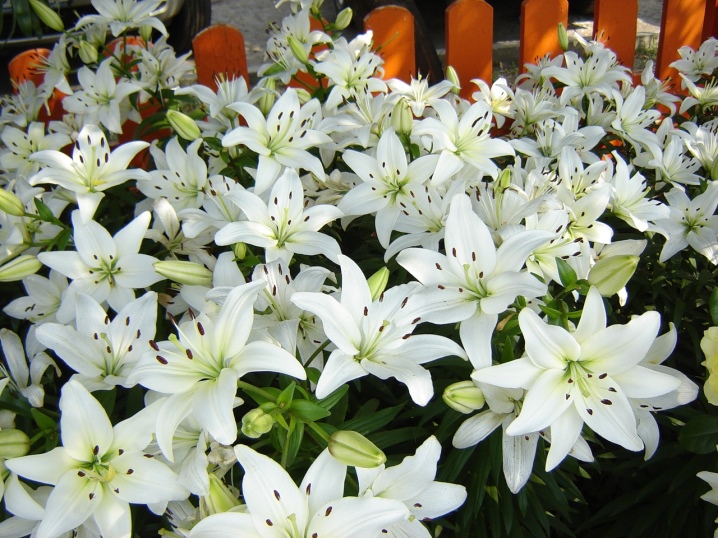
- The view is used where the bud is in the shape of a tube. It goes well with brighter colors.

The following video will tell you how to care for lilies after flowering.







































































































The comment was sent successfully.